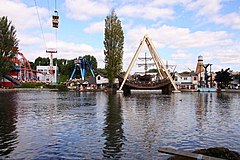
The Birmingham and Fazeley Canal is a canal of the Birmingham Canal Navigations in the West Midlands of England. Its purpose was to provide a link between the Coventry Canal and Birmingham and thereby connect Birmingham to London via the Oxford Canal.
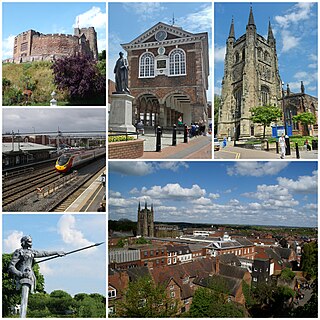
Tamworth is a market town and borough in Staffordshire, England, 14 miles (23 km) north-east of Birmingham. The town borders North Warwickshire to the east and north, Lichfield to the north, south-west and west. The town takes its name from the River Tame, which flows through it. The population of Tamworth borough (2021) was 78,838. The wider urban area had a population of 81,964.

The Coventry Canal is a navigable narrow canal in the Midlands of England.

The River Tame is a river in the West Midlands of England, and one of the principal tributaries of the River Trent. The Tame is about 95 km (59 mi) long from the source at Oldbury to its confluence with the Trent near Alrewas, but the main river length of the entire catchment, i.e. the Tame and its main tributaries, is about 285 km (177 mi).

Lichfield District is a local government district in Staffordshire, England. The district is named after its largest settlement, the city of Lichfield, which is where the district council is based. The district also contains the towns of Burntwood and Fazeley, along with numerous villages and surrounding rural areas.
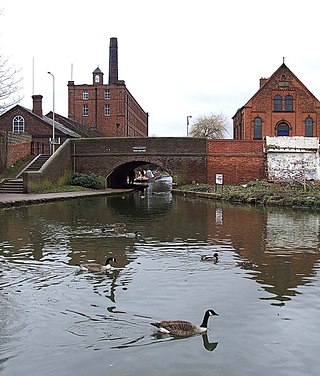
Fazeley is an industrial town and civil parish in the Lichfield District in Staffordshire, England. Fazeley is located on the outskirts of Tamworth and the civil parish of Fazeley also includes Mile Oak and Bonehill. Fazeley forms part of the Tamworth Built-up area.
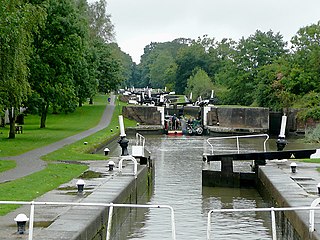
The Warwickshire ring is a connected series of canals forming a circuit around the West Midlands area of England. The ring is formed from the Coventry Canal, the Oxford Canal, the Grand Union Canal, the Stratford-upon-Avon Canal and the Birmingham and Fazeley Canal. It is a popular route with tourists due to its circular route and mixture of urban and rural landscapes.

Drayton Manor Resort is a family theme park, zoo and accommodation in the grounds of the former Drayton Manor, in Drayton Bassett, Staffordshire, England, UK. It covers 180 acres, of which about 113 acres are in use, and hosts about 1.5 million people each year. It is the fourth-largest amusement park in the UK by land area at 280 acres. The park is also home to Thomas Land and Drayton Manor Zoo, home to over 500 animals, including Red pandas, Eurasian lynx, Sumatran tigers and a variety of monkeys and gibbons.
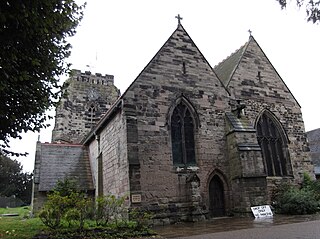
Polesworth is a large village and civil parish in the North Warwickshire district of Warwickshire, England. It is situated close to the northern tip of Warwickshire, adjacent to the border with Staffordshire. It is 3 miles (5 km) east of Tamworth, and is 5 miles (8 km) northwest of Atherstone.
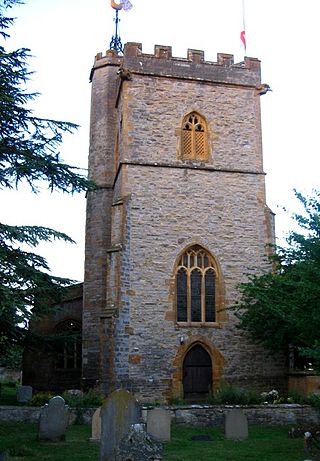
Drayton is a village and civil parish in Somerset, England, focussed less than a mile from Curry Rivel and five miles southwest of Somerton in the South Somerset district. It adjoins the River Isle, near its confluence with the Parrett, and the former Westport Canal. The parish includes the hamlet of Midelney.

Drayton Manor, one of Britain's lost houses, was a British stately home at Drayton Bassett, since its formation in the District of Lichfield, Staffordshire, England. In modern administrative areas, it was first put into Tamworth Poor Law Union and similar Rural Sanitary District, 1894 to 1934 saw its inclusion in Tamworth Rural District, and in the next forty years it lay in the 1974-abolished Lichfield Rural District.

The A453 road was formerly the main trunk road connecting the English cities of Nottingham and Birmingham. However, the middle section of this mainly single-carriageway road has largely been downgraded to B roads or unclassified roads following the construction of the parallel M42-A42 link around 1990. The M42 was originally meant to pass further north than it does, and to join the M1 at Sandiacre in Derbyshire. The M42/A42 does not enter Derbyshire, but instead joins the M1 closer to the A453 junction at Kegworth. The A42 shadows the former A453 from Appleby Magna to Castle Donington. The road historically connected the East Midlands with the West Midlands.

Sir Robert Peel, 1st Baronet, was a British politician and industrialist and one of early textile manufacturers of the Industrial Revolution. He is one of ten known British millionaires in 1799.
Joseph Wilkes (1733–1805) was an 18th-century English industrialist and agricultural improver born in the village of Overseal in Derbyshire but more commonly associated with the village of Measham in Leicestershire.

Fazeley Junction is the name of the canal junction where the authorised Birmingham and Fazeley Canal terminates and meets the Coventry Canal at Fazeley, near Tamworth, Staffordshire, England.
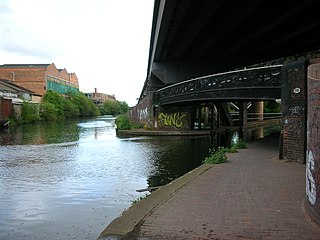
Salford Junction is the canal junction of the Grand Union and Tame Valley Canals with the Birmingham and Fazeley Canal. It is in the north of the administrative city of Birmingham, England and historically marked a tripoint between two divisions of Aston to the south and Erdington to the north. It is directly east of most of the Gravelly Hill Interchange. With Aston and Bordesley Junctions it forms a circuit, at the heart of Birmingham's thirty-five miles of canals.

Glascote is an area of Tamworth, in the Tamworth district, in Staffordshire, England. The area centres on the Glascote Road, and is mainly residential with a few convenience stores and pubs.

Tamworth Greyhound Stadium was a greyhound racing and speedway stadium in Fazeley near Tamworth, Staffordshire.

Tamhorn is a former civil parish, now in the parish of Fisherwick, in the Lichfield district, in the county of Staffordshire, England, 2+1⁄2 miles north-west of Tamworth. It was an extra-parochial area in Offlow hundred until 1858, when it became a civil parish. It was annexed to Fisherwick parish on 1 April 1934. It had an area 770 acres. The population was 5 in 1841 and 19 in 1931, the last census before its annexation.
Drayton Bassett is a civil parish in the district of Lichfield, Staffordshire, England. It contains six buildings that are recorded in the National Heritage List for England. Of these, one is listed at Grade II*, the middle grade, and the others are at Grade II, the lowest grade. The parish contains the village of Drayton Bassett and the surrounding area. The Minworth to Fazeley branch of the Birmingham and Fazeley Canal passes through the parish, and the listed buildings associated with this are three bridges of differing types. The other listed buildings are a church, a house, and a farmhouse.

